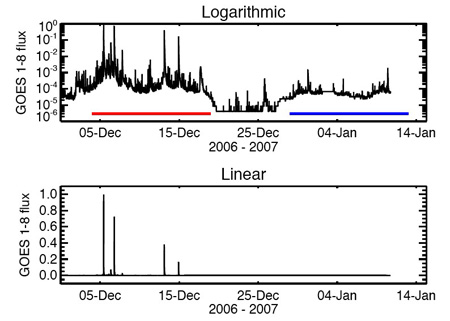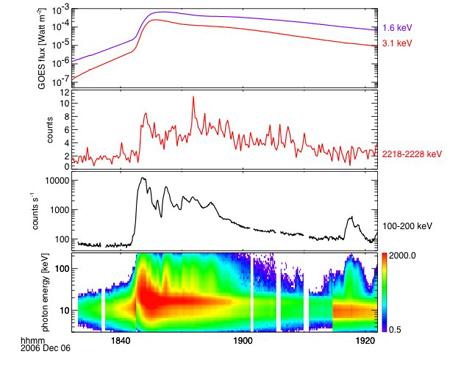A last best active region
| Nugget | |
|---|---|
| Number: | 43 |
| 1st Author: | Säm Krucker |
| 2nd Author: | Hugh Hudson |
| Published: | 22 January 2007 |
| Next Nugget: | John Brown and the thick-target model |
| Previous Nugget: | A solar X-ray dentist mirror |
Introduction
The solar sunspot cycle always has a boring stretch in between maxima - or does it? By "boring" we mean not so many powerful flares and CMEs, but in fact an early Yohkoh science nugget points out that these are just the ones that might be very interesting indeed. In 1996 a "last best region" occurred, with NOAA number 7983. Our new "last best region," half a 22-year solar cycle later, is NOAA 10930 (as illustrated in Figures 1 and 2 below). Thus by simple arithmetic there must be about 3000 sunspot groups per cycle... This region's sunspot area made it roughly the 20th biggest group from Solar Cycle 23. It is highly unlikely that there will be a bigger one before the new cycle begins, anticipated in 2007, hence the classification as "last best."

The flares
This sunspot group produced powerful flares with many interesting observations. For example, there were excellent Hα data showing a "solar tsunami" (usually called a Moreton wave) making an appearance in the Astronomy Picture of the Day site. While RHESSI did not observe that flare particularly well, the earlier one (GOES X6.5) on Dec. 6 was excellent - see Figure 2 below - with >100 keV emission lasting for an hour or so.
As one can see in Figure 1, especially clearly with the lower plot on a linear scale, there were four major flares in the first rotation, and none in the second. This is how the 1996 "last best" region worked - on the first rotation, during the eruption of the spot group, there were major flares; on subsequent rotations only minor ones. This is part of the general picture that "emerging flux" has a lot to do with flare activity - the solar magnetic field bubbles through the photosphere in some manner following its creation in a deep-interior dynamo.
What will we learn?
RHESSI did detect line γ-rays from these events, something that suprised the team in a couple of ways. First, we really did not expect to see major flares so late in the cycle; second, the Ge detectors have been accumulating radiation damage which we intend to correct via an annealing process. At present the spectral resolution is reduced and thus so is the sensitivity to line emission. This odd occurrence pattern - powerful events at the very end of a solar cycle - has been noted before and may have complicated consequences and/or explanations. For example, flare-induced seismic waves (not the "tsunami" or Moreton surface waves, but "sunquake" waves in the interior) were first noted for the 1997 solar-minimum flare.
The most exciting aspect of these flare, though, is the anticipation of Hinode observations. These include many things that RHESSI does not do: magnetic fields, soft X-rays, XUV spectroscopy - and it is known that excellent observations exist. This spacecraft was launched just in time to observe this "last best region," very fortunate, and we will try to do another science nugget when some of their material becomes available and we can do comparisons. observations.
Biographical Note
Sam Krucker and Hugh Hudson are RHESSI team members in Berkeley.
